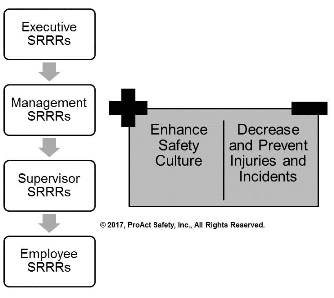What Are Your Safety Roles, Responsibilities, and Results?
Individuals at any level should be able to see themselves as actors in the strategy.
You have 12 months to prepare for the following question. What are your most important safety roles, responsibilities, and results (SRRRs) that will most directly contribute to shaping your desired safety culture and prevent the most injuries and incidents? If a leader can't quickly recite their most important safety responsibilities, don’t expect that those they lead can, either.
World-class organizations create and execute on their safety improvement plan in the same manner they approach growing their market share and company worth: strategically. A strategy in safety should provide insight to any individual in the company: where they are going and what success will look like, where they currently are, the critical strategic priorities and the initiatives that support them, a balanced measurement system (leading, lagging, and value-focused measurements), and, most importantly, the roles and responsibilities of individuals within the system to execute on the plan. Individuals at any level should be able to see themselves as actors in the strategy.
Everyone should be able to quickly identify what is expected of them in the role they will play, the most important responsibilities to support this role, and what results would be experienced if executed. How clear are these expectations within your organization and how do they align with your strategy?
During assessments of strategy, culture, and execution capabilities of client organizations, the clarity of expectations is assessed with the Chemistry of Safety Culture ExcellenceSM model (see "Evolving Your Safety Culture: Elements that Matter Most," July 2014, OH&S magazine). This element is scored on a range of 1-10. Expectations is ranked high when "everyone is not only aware of what results are expected, but also what is expected of them individually for further safety improvement." How would members of the different levels within your organization rate this?

Leaders are responsible for the results of the people they supervise. Because safety performance and current culture are results, this, too, is under their purview. While culture change happens best from within and through involvement of the rank and file, the direction must be set from the top. In many organizations, if someone is asked what is expected in safety, the answer is often "zero injuries." While this is a vital goal, what it takes to make that a sustained reality is even more important. This is where the significance of SRRRs comes into view.
A role is how you will be perceived (great communicator, coach, or inspiring leader). A responsibility is what you will be observed doing to fulfill that role (regularly speaking to employees about the behaviors that are required in safety and the significant few that are most desired). Results are what should happen, what could be measured, as a result of acting on your roles (any employee when approached can list the top three behaviors requested of them). While this is a simple example, more specific, detailed examples should be created for all levels of the organization.
Each leader should have some examples available to them to prompt thinking. However, the decision of which SRRRs to focus on should directly support the strategy, including measurements to determine whether the efforts are contributing sustainable value or not.
Take the following scenario as a challenge: In 12 months, I will be engaged by your firm to assess the effectiveness of your efforts, focus, culture, and strategy. I will review the current focus of your strategy and, after data collection and analysis, will know precisely where the focus should be and the most important safety roles, responsibilities, and results necessary to accomplish the focus and yield improvement.
I will then approach a sampling of the leaders in your organization and ask them one question, "What are your two most important responsibilities to most directly enhance the safety culture and prevent the most injuries and incidents?" How prepared will you be? While different locations, departments, and needs will dictate different responses, how accurate, strategic, and data-driven will the responses be?
The author invites you to share your plans and subsequent results in the 12 months that follow reading this article.
This article originally appeared in the August 2017 issue of Occupational Health & Safety.